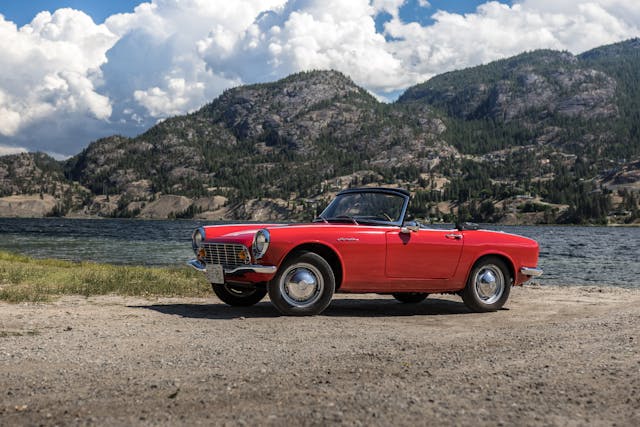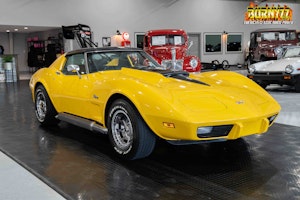Media | Articles
These 6 Oddball Classics Got a Little Pricier This Year
We track thousands of vehicles in the Hagerty Price Guide. Many of them fit into nice, mainstream segments—muscle cars, British classics, trucks, Ferraris, etc. Others don’t fit so neatly into standard buckets, but these oddballs are also some of our favorites. And although the audience for them isn’t as big as something like, say, Corvettes, the prices for weird and wonderful classics also fluctuate and it’s important to track them, too. Below are some of the oddballs that have had the best start to 2024.
1959-65 BMW 700: +63 percent

BMWs aren’t typically oddballs. In fact, they’re pretty mainstream. By sales volume, BMW sold the ninth most cars out of any company in the world last year. In the early 1960s, though, things were different, and the brand with the beachball badge was in search of identity. In the postwar years, its upmarket models weren’t successful, while small offerings like the Isetta microcar kept the lights on at Bayerische Motoren Werke. Seeing that buyer tastes were shifting away from microcars and to larger, more comfortable offerings, BMW responded with the 700. Like the Isetta and the BMW 600 before it, the 700 used a rear-mounted motorcycle engine—in this case a 697cc version of the flat-twin found in the R67 motorcycle—and four-speed gearbox. Riding on BMW’s first steel monocoque frame, it was available as a coupe, a two-door sedan with a taller and more spacious roofline, and a convertible.
BMW itself has dubbed the 700 “the car that saved the company” and sold over 188,000 units when it desperately needed the sales, but they never moved in large numbers in this country. They don’t often pop up for sale now, but some big recent results, including a $33,867 coupe and a $40,533 convertible, showed we were a bit behind on pricing for these obscure but important Bimmers. Condition #2 (excellent) values now range from $34,600 for a base two-door sedan to $75,500 for the rare convertible.
1964-70 Honda S600/800: +21 percent

Another unconventional but important car for a major automaker is the Honda S600. While not technically Honda’s first four-wheeled vehicle, it marked an important shift for what was then primarily a motorcycle company, and had some quirky but impressive elements of its design. Its 606cc four-cylinder is cast aluminum, leans left at a 45-degree angle, has double overhead cams, revs to a 9500 rpm redline, and drives the rear wheels not via shaft but via chain. It makes just 57hp and 38 lb-ft of torque, but only has 1600 pounds of Honda to push around.
Its size, styling, and performance are roughly similar to the MG Midget and Triumph Spitfire, but the Japanese upstart only lasted from 1964-66, and the similar S800 that succeeded it only lasted until 1970. Its British rivals, however, lasted another decade. Even so, the Honda is more sophisticated, more significant, and much rarer, particularly in the U.S. where it was never officially sold. They’re also much more valuable. S600s/S800s have been steadily increasing in value for over a decade, but some recent sales like a record $109,000 result earlier this year have pushed them even further. Current #2 values for an S600 range from $48,600 for a coupe to $66,000 for a convertible, and for an S800 a similar $58,100 for a coupe to $65,900 for a convertible.
Marketplace
Buy and sell classics with confidence
1969-74 Volvo 142: +15 percent

The 140 series, introduced in 1966, marked a few of firsts for Volvo. It marked the company’s shift away from the ’60s curves of cars like the Amazon and 1800 to the boxy brick era for which the company is probably best known. It also introduced Volvo’s three digit nomenclature, with the first digit indicating series, the second digit the number of cylinders, and the third digit the number of doors. So, a 142 was part of the 100 series, with a four-cylinder engine, and a two-door coupe body style. The 140 series also came in 144 (4-door sedan) and 145 (5-door wagon) styles.
Volvo sold over 1.25 million 142/144/145s in eight years, and nearly 413,000 of those were 142 coupes. These were utilitarian cars. Few people bothered to save them, and 140s were very much overshadowed by the 240s that came after them. Several big results for 140s, but particularly for the coupe-bodied 142s, have come up over the past several months and resulted in a significant price bump. That said, these boxy Swedes have been inexpensive for a very long time, so a significant appreciation in percentage terms isn’t all that much in pure dollar terms. Depending on year and spec, #2 condition values for 142s still only range from $15,100 to $17,500.
1949-52 Crosley CD: +12 percent

When postwar America tooled up for a decade of tailfins, chrome and big V-8s, Cincinnati-based Crosley thought smaller…much smaller. Although Crosley was the first US carmaker to offer a mass-market overhead cam engine and among the first carmakers anywhere to use disc brakes, it is mostly remembered for its pint-sized Hot Shot sports car, the toy Jeep-like Farm-O-Road, and the small but surprisingly practical CC/CD.
The 1949-52 CD was available in wagon, sedan, convertible, panel delivery, and pickup body styles. The two-door sedan body style is the cheapest but has appreciated the most in recent months with a 20 percent increase. Their #2 value is still just $10,800, though, while the most expensive station wagon models are still just $20,800.
1985-91 Subaru XT: +17 percent

In the 1980s, long before love made a Subaru a Subaru, the brand was known mostly for yawn-worthy family cars or quirky, fun vehicles like the BRAT pickup. Arguably even quirkier than the BRAT, though, was the XT, Subaru’s take on the compact Japanese sports coupe market that was booming at the time.
Styling-wise, the XT was ’80s wedge taken to the extreme, with aircraft-inspired wraparound rear glass and wheels that looked like a sheet of graph paper. The basic shape, and clever touches like door handles that fit flush to the body helped make the XT the most aerodynamic car sold in America at the time. Things got even stranger inside: The XT had a digital gauge cluster that looked like a contemporary arcade game, a shifter that looked like the yoke of a fighter jet, checker-pattern cloth seats, and a goofy two-spoke, asymmetrical steering wheel that would make Citroën blush. But among all the weirdness were a lot of features that were ahead of their time or at the very least very uncommon, like height-adjustable suspension, central locking, available all-wheel drive (activated via a button on top of the shifter), and a gauge cluster that adjusted with the steering wheel. “The kind of car Mercedes might have built if they were a little more frugal and a lot more inventive,” said one ad.
What wasn’t cutting edge was the performance, and the 1.8-liter flat-four, even in turbocharged form, made less than 120 hp. A 1988 facelift brought a six-cylinder XT6 model with 145hp, but the facelift brought more conventional looks that ditched many of the quirks enthusiasts find charming today.
XTs never sold well and few people bothered to pamper theirs, so clean examples are rare. One did pop up late last year, however, and it sold for over 18 grand. Which doesn’t sound like much, but it’s the most expensive XT we’ve seen sell by a long way.
1962-63 Studebaker Lark: +11 percent

In the early 1960s, Studebaker was still one of the most recognizable names on American roads, but the Indiana-based company was living on borrowed time, and wouldn’t survive to the end of the decade. The Lark was the brand’s volume-selling compact, first introduced in 1959. When the Big Three introduced compacts of their own compacts at the dawn of the 1960s, Lark sales suffered, but a restyle by designer Brooks Stevens for the 1962-63 generation Lark helped, and sales improved. Larks of this period came with either a 170-cid six-cylinder, or V-8s of either 259 or 289 cid, and in sedan, station wagon, coupe, or convertible body styles.
Generally, cars from this period and especially ones from defunct brands like Studebaker haven’t done much price-wise in recent years, but Larks are an affordable way to get an unusual, stylish V-8 classic, and strong sale prices have pushed them up 10 percent across body styles and model years. They’re still inexpensive, though, as the most costly 289 convertible is $29,000 in #2 condition, and a six-cylinder sedan doesn’t even hit 10 grand.
***
Check out the Hagerty Media homepage so you don’t miss a single story, or better yet, bookmark it. To get our best stories delivered right to your inbox, subscribe to our newsletters.


















Yes we have the same issues with road salt in CNY so we can drive our nice cars about 2 months out of the year and still wash em every other day !!!!!!